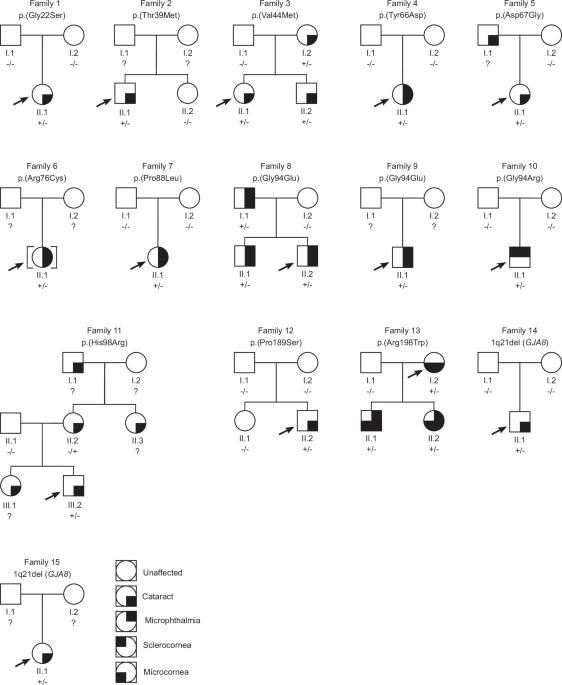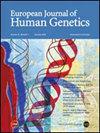GJA8-associated developmental eye disorders: a new multicentre study highlights mutational hotspots and genotype-phenotype correlations
IF 4.6
2区 生物学
Q2 BIOCHEMISTRY & MOLECULAR BIOLOGY
引用次数: 0
Abstract
Variants in gap junction protein alpha 8 (GJA8), the gene encoding connexin 50 (Cx50), are primarily associated with developmental cataract, although some are associated with severe structural eye anomalies, such as aphakia (absent lens), microphthalmia (small eyes), and sclerocornea. To further define the relationship of GJA8 variants to ocular developmental disorders, we screened four large international cohorts with structural eye anomalies, including anophthalmia, microphthalmia, and coloboma (AMC) or cataracts. We identified 15 new families carrying 14 different heterozygous GJA8 variants (12 missense variants and two 1q21 microdeletions). The missense variants comprised 10 previously reported alterations in cases with eye anomalies [p.(Gly22Ser), p.(Val44Met), p.(Asp67Gly), p.(Arg76Cys), p.(Pro88Leu), p.(Gly94Glu), p.(Gly94Arg), p.(His98Arg), p.(Pro189Ser), and p.(Arg198Trp)] and two not yet linked with disease [p.(Thr39Met) and p.(Tyr66Asp)]. Their associated phenotypes ranged from isolated cataracts to a combination of microphthalmia and cataract with/without sclerocornea. Our study confirms GJA8 variants as an important source of genetic diagnoses for families with structural eye anomalies in addition to cataract and highlights specific mutational hotspots. Furthermore, we confirm an important genotype-phenotype correlation between sclerocornea and the p.(Gly94Arg) variant, and detail intra- and inter-familial phenotypic variability, which is important for clinical assessment and genetic counselling.

gja8相关的发育性眼病:一项新的多中心研究强调了突变热点和基因型表型相关性。
编码连接蛋白50 (Cx50)的间隙连接蛋白- 8 (GJA8)的变异主要与发育性白内障有关,尽管有些变异与严重的眼结构异常有关,如无晶状体、小眼和角膜硬化。为了进一步确定GJA8变异与眼部发育障碍的关系,我们筛选了四个大型国际队列,其中包括眼无症、小眼症、结肠瘤(AMC)或白内障。我们鉴定了15个携带14种不同杂合GJA8变体的新家族(12种错义变体和2种1q21微缺失)。错义变异包括10个先前报道的眼部异常病例的改变[p.(Gly22Ser), p.(Val44Met), p.(Asp67Gly), p.(Arg76Cys), p.(Pro88Leu), p.(Gly94Glu), p.(Gly94Arg), p.(His98Arg), p.(Pro189Ser), p.(Arg198Trp)]和两个尚未与疾病相关的[p.(Thr39Met)和p.(Tyr66Asp)]。他们的相关表型范围从孤立的白内障到小眼和伴有/不伴有硬角膜的白内障的组合。我们的研究证实了GJA8变异是除白内障外的结构性眼异常家庭遗传诊断的重要来源,并突出了特定的突变热点。此外,我们确认了硬角膜与p.(Gly94Arg)变异之间的重要基因型-表型相关性,并详细说明了家族内和家族间的表型变异性,这对临床评估和遗传咨询很重要。
本文章由计算机程序翻译,如有差异,请以英文原文为准。
求助全文
约1分钟内获得全文
求助全文
来源期刊

European Journal of Human Genetics
生物-生化与分子生物学
CiteScore
9.90
自引率
5.80%
发文量
216
审稿时长
2 months
期刊介绍:
The European Journal of Human Genetics is the official journal of the European Society of Human Genetics, publishing high-quality, original research papers, short reports and reviews in the rapidly expanding field of human genetics and genomics. It covers molecular, clinical and cytogenetics, interfacing between advanced biomedical research and the clinician, and bridging the great diversity of facilities, resources and viewpoints in the genetics community.
Key areas include:
-Monogenic and multifactorial disorders
-Development and malformation
-Hereditary cancer
-Medical Genomics
-Gene mapping and functional studies
-Genotype-phenotype correlations
-Genetic variation and genome diversity
-Statistical and computational genetics
-Bioinformatics
-Advances in diagnostics
-Therapy and prevention
-Animal models
-Genetic services
-Community genetics
 求助内容:
求助内容: 应助结果提醒方式:
应助结果提醒方式:


